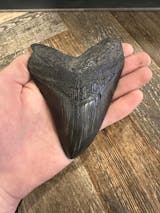Florida is one of the most fossil-rich states in the U.S., particularly for marine fossils. Among the most sought-after are the teeth of Carcharocles megalodon, the largest shark species to have ever lived. This guide will explain where and why megalodon teeth are found in Florida, the science behind it, and the best ways to responsibly search for them.
🦈 Understanding Megalodon Teeth and Florida’s Fossil Record
The megalodon shark roamed the oceans between approximately 15 and 3 million years ago, during the Miocene and Pliocene epochs. Florida’s geological history—once submerged under warm, shallow seas—created ideal conditions for preserving fossilized marine life, including megalodon teeth.
The phosphate-rich layers of sediment and eroded ancient sea beds across the state now offer public access to these fossil-bearing zones. Over time, rivers, erosion, and coastal tides have helped expose and redistribute these fossils to the surface, making them discoverable to collectors and researchers alike.
📍 Key Locations to Search for Megalodon Teeth in Florida
1. Peace River (DeSoto and Hardee Counties)
Geological context: The Peace River cuts through the Hawthorn Group and Peace River Formation, which are rich in marine vertebrate fossils.
What you’ll find: Megalodon teeth, other fossil shark teeth such as mako, great white, hemipristis, lemon, bull, etc, dugong ribs, fossilized bone fragments, extinct mammal remains such as mammoth, mastodon, three-toed horse, giant sloth, and so much more.
Best practices:
- Focus on shallow gravel beds.
- Ideal conditions are during the dry season (late fall to early spring).
- A Florida Fossil Permit is not required for shark teeth, but is mandatory for collecting other vertebrate fossils.
- If you're scuba certified, you can also dive these rivers.
- Look up local fossil excursions if you don't want to dig by yourself or explore these areas alone.
Scientific Tip: Fossils are often concentrated in lag deposits—areas where flowing water has naturally sorted heavier materials like teeth and bones.
2. Venice Beach and Caspersen Beach (Sarasota County)
Geological context: Offshore dredging and coastal erosion continually bring fossilized teeth to the surface.
What you’ll find: Smaller megalodon teeth, other small fossil shark teeth, such as lemon, bull, hammerhead, mako, and great white.
Best practices:
- Use a sand scoop or shark tooth sifter during low tide.
- Storm surges often reveal new material.
- If you're scuba certified, you can dive off the coast and find bigger megalodon shark teeth along with other amazing fossils. There are plenty of charters that will take you out to go and look for megalodon teeth.
Educational Note: These beaches are built on ancient marine deposits and are constantly replenished with fossil material due to Gulf wave action.
3. Myakka and Caloosahatchee Rivers
Geological context: These rivers also expose the Peace River Formation and Caloosahatchee Formation, both known for fossil preservation.
What you’ll find: Megalodon and other shark teeth, prehistoric turtle and mammal remains.
Best practices:
- Bring a kayak or canoe for better access to fossil sites.
- Be aware of changing water conditions and local wildlife (including alligators).
Scientific Insight: Fossil material in rivers is often more eroded, but large teeth, like megalodon teeth, can still be found due to sediment shifts and riverbank collapse.
4. Gainesville Area Creeks
Geological context: Smaller creeks around Gainesville cut through Miocene-aged sediments, exposing isolated fossil deposits.
What you’ll find: Megalodon teeth (less common), other shark species, bony fish remains.
Best practices:
- Check property lines before entering creeks; many are on private land or protected areas.
- Fossil-rich sediments tend to concentrate after seasonal floods.
- Do not bring tools, it is illegal to dig in these creeks.
- Bring some tough gloves, you can still move around gravel with your hands and find megalodon teeth, but it's hard work.
Conservation Tip: Avoid disturbing the surrounding banks and always collect fossils ethically and legally.
🧰 Recommended Equipment for Fossil Hunting
- Sifter or screen box: Essential for river and creek hunting.
- Waders or water shoes: Protect feet and allow longer search time in water.
- Mesh bag or tackle box: For storing finds safely.
- Permits: Required for non-shark vertebrate fossils on state lands. Apply here
- Snorkeling/diving gear: Optional, but useful for deeper sites and offshore searching.
⚠️ Ethical and Legal Considerations
- Shark teeth are exempt from fossil permit requirements in Florida, but mammal and reptile fossils are not.
- Always get permission before searching on private property.
- Follow Leave No Trace principles—fill holes, minimize disturbance, and avoid littering.
- Stay aware of local wildlife (e.g., snakes, alligators, insects).
🧠 Scientific Takeaways for Fossil Hunters
- Why are teeth so common? Teeth are highly durable and composed of enamel, which fossilizes more readily than cartilage or bone.
- Why Florida? Florida’s slow geological uplift and phosphate-rich sediments make it a prime location for fossil preservation and exposure.
- How old are the fossils? Megalodon teeth in Florida typically range from 3 to 15 million years old.
Conclusion
Fossil hunting in Florida offers a unique blend of science, adventure, and deep-time discovery. Whether you're an amateur collector or an aspiring paleontologist, Florida’s rivers and beaches provide one of the best opportunities in the world to unearth real megalodon teeth. With the right preparation and knowledge, your next trip could lead to uncovering a tooth from a 60-foot predator that once ruled the ancient seas.



